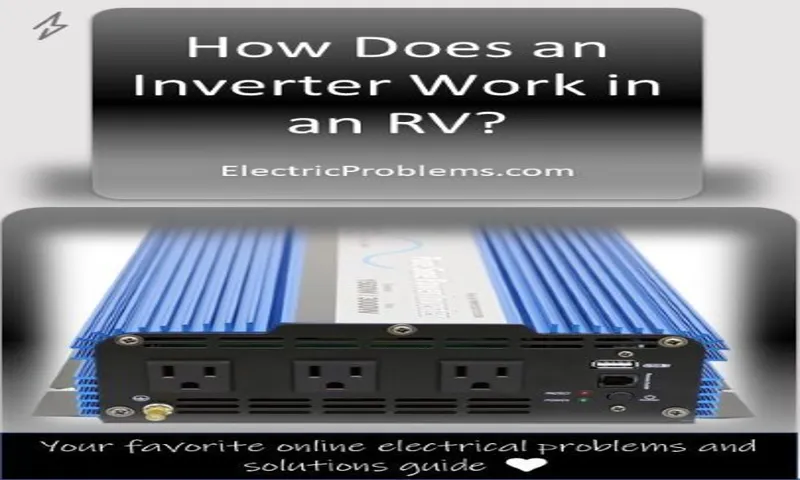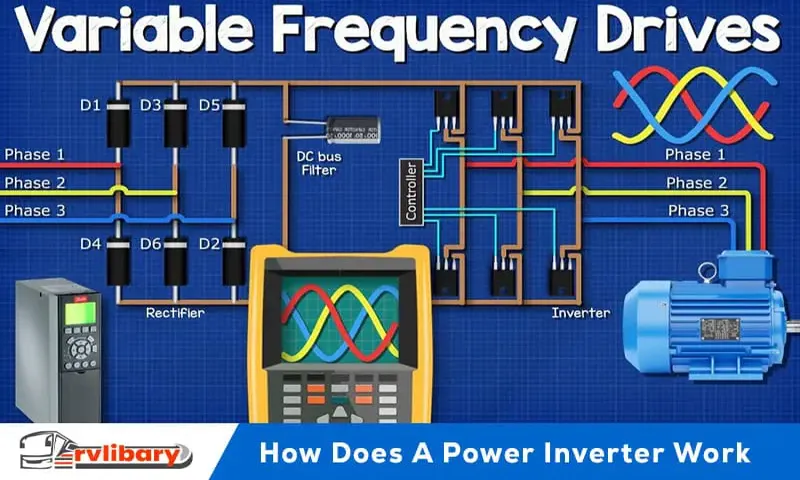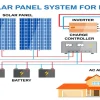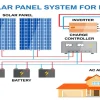If you’re new to the world of camping, you may have heard the term “power inverter” tossed around but aren’t quite sure what it means. Don’t worry, you’re not alone! Understanding the basics of power inverters in campers is essential for ensuring you have a reliable and efficient power source while exploring the great outdoors. Think of a power inverter as a translator for your camper’s electrical system.
It takes the 12-volt DC power from your camper’s battery and converts it into 120-volt AC power, similar to what you would find in a regular household outlet. This allows you to power various electronic devices and appliances, such as laptops, smartphones, refrigerators, and even small appliances like microwaves or coffee makers, while camping off-grid or during power outages. Power inverters come in different sizes, types, and power capacities, allowing you to choose one that suits your needs.
The size and power capacity of the inverter will determine how many devices you can power simultaneously and for how long. So, it’s essential to understand the power requirements of the devices you plan to use and select a power inverter that can handle the load. Inverter types can range from modified sine wave inverters, which are more affordable but may not provide as clean and consistent power, to pure sine wave inverters, which produce power that is closer to what you would get from a regular household outlet.
Pure sine wave inverters are usually pricier but are recommended for powering sensitive electronics or appliances that require a stable power supply. Now that you have a basic understanding of what a power inverter is and how it works, you can make a more informed decision when it comes to choosing the right one for your camper. Stay tuned for our next blog post, where we will dive deeper into the different types of power inverters and their specific use cases.
Happy camping!
Table of Contents
What is a power inverter?
Power inverters are a crucial component in a camper, allowing you to convert DC power from your camper’s battery into AC power that can be used to run various appliances and devices. But how do power inverters actually work? Well, it’s quite simple! When you plug in a device or appliance into a power outlet in your camper, it requires AC power to function. But since your camper’s battery provides DC power, the power inverter steps in to bridge the gap.
Think of a power inverter as a translator between different languages. Just like how a translator converts one language into another so that people can communicate, a power inverter converts DC power into AC power so that your devices can function properly. It takes the direct current from your camper’s battery and converts it into alternating current, which is what appliances and devices need to operate.
This allows you to use devices like televisions, microwaves, and laptops in your camper, even when you’re not connected to an external power source. Power inverters come in different wattages, so it’s important to choose the right one for your needs. A higher wattage inverter can power larger appliances, while a lower wattage one is suitable for smaller devices.
Additionally, you’ll need to consider the power requirements of the appliances and devices you plan to use, as well as the capacity of your camper’s battery. Overall, power inverters are essential for a comfortable and convenient camping experience. They allow you to power your devices and appliances while on the road, ensuring that you have all the comforts of home wherever you go.
So whether you want to watch a movie, make a cup of coffee, or charge your phone, a power inverter is the key to making it all possible in your camper.
Definition and Purpose
power inverter, inverters, definition, purpose

Types of power inverters
power inverters, types of power inverters
How does a power inverter work in a camper?
If you’re an avid camper or frequently travel in your camper van, you may have wondered how a power inverter works in a camper. Well, let me break it down for you. A power inverter is a device that converts DC (direct current) power from your camper’s battery into AC (alternating current) power, which is what most of our electrical appliances and gadgets use.
Think of it as a translator between your camper’s battery and the electrical devices you want to power. So, when you plug in your phone charger or turn on a small appliance like a toaster or a blender, the power inverter takes the DC power from your camper’s battery and converts it into the AC power that these devices need to operate. It’s like having a universal adapter that allows you to use electrical devices from different countries, but in this case, it’s adapting the power from your camper’s battery to power your appliances.
It’s a clever piece of technology that makes camping and living on the road more convenient and comfortable. So, the next time you’re enjoying the great outdoors in your camper, you can rest assured knowing that your power inverter is there to keep your appliances running smoothly.
Converting DC to AC power
power inverter, DC to AC power, camper Have you ever wondered how you can power your appliances and electronics in your camper when you’re not connected to a shore power source? That’s where a power inverter comes in handy! A power inverter is a device that converts DC (direct current) power from your camper’s battery or solar panels into AC (alternating current) power that can be used to run your electrical devices. So how does a power inverter actually work? Well, it all starts with the input DC power. This power is fed into the inverter, which then uses electronic circuits to convert it into AC power.
The inverter essentially takes the DC power and switches it on and off at a rapid rate, creating a waveform that resembles the AC power found in your home. This converted AC power is then sent to the outlets in your camper, allowing you to plug in and use your devices. In addition to converting power, a power inverter also regulates the voltage and frequency of the output AC power.
This ensures that the power being supplied to your appliances and electronics is at the proper levels, preventing damage and ensuring optimal performance. There are different types of power inverters available, ranging from small inverters that can power a few devices to larger, more powerful inverters that can handle larger loads. Some inverters also come with additional features such as built-in surge protection, USB ports for charging devices, and even remote monitoring capabilities.
Overall, a power inverter is an essential piece of equipment for any camper or RV owner who wants to have access to AC power while on the road. It allows you to power your appliances and electronics, making camping experiences more comfortable and convenient. So the next time you’re planning a trip in your camper, don’t forget to pack a power inverter!
Regulating voltage and frequency
power inverter, camper, regulating voltage, frequency
Key components of a power inverter
You may be wondering how a power inverter works in a camper. Well, let me break it down for you! A power inverter is a device that converts the DC (direct current) power from your camper’s battery into AC (alternating current) power, which is the type of power used in most household appliances and electronic devices. This conversion is necessary because most campers run on DC power, while many of the appliances we use on a daily basis require AC power.
The inverter acts as a bridge between the two types of power, allowing you to use your camper’s battery to power things like televisions, microwaves, and even air conditioners. It’s like having a mini power station right inside your camper! So, when you’re out in the wilderness, you can still enjoy all the comforts of home without having to rely on external sources of power. How cool is that?
DC input source
power inverter, DC input source, key components
Conversion circuitry
“power inverter” Power inverters are essential devices that allow you to convert DC power from a battery into AC power that can be used to power various devices and appliances. One of the key components of a power inverter is the conversion circuitry. This circuitry is responsible for the actual conversion of the power from DC to AC.
It consists of several elements, including transistors, diodes, capacitors, and transformers. These components work together to transform the low voltage DC power into high voltage AC power with the desired frequency and waveform. The transistors and diodes control the flow of electricity, while the capacitors and transformers help to smooth out and regulate the power output.
Without this conversion circuitry, a power inverter would not be able to perform its function of converting DC power into AC power. So next time you use a power inverter to power your devices on the go, remember the important role that the conversion circuitry plays in making it all possible.
AC output
AC output, power inverter, key components, convert DC to AC, transformer, MOSFET, rectifier, filter circuit When it comes to power inverters, one of the most important features is the AC output. This is what allows the inverter to convert DC power to AC power, which is what most household appliances and electronics use. But how does it do this? Well, there are a few key components that make it all possible.
The first component is the transformer. This is responsible for stepping up or stepping down the voltage of the incoming DC power. It does this by using a pair of coils wound around a core.
By varying the number of turns on each coil, the transformer can change the voltage to match the required output. Next is the MOSFET, or metal-oxide-semiconductor field-effect transistor. This component acts as a switch, turning the DC power on and off rapidly to create the AC output.
The MOSFET is controlled by a microcontroller, which determines the frequency and waveform of the output. Another important component is the rectifier. This converts the AC output to DC in order to power the inverter itself.
The rectifier is usually a diode bridge, which allows current to flow in only one direction. Finally, there is the filter circuit. This is responsible for smoothing out the output waveform, removing any unwanted noise or distortion.
The filter circuit typically consists of capacitors and inductors, which help to smooth out the voltage and current. So, while the concept of converting DC power to AC power may seem complex, it is made possible by these key components working together. The transformer steps up or steps down the voltage, the MOSFET acts as a switch, the rectifier converts the AC to DC, and the filter circuit smooths out the waveform.
Safety features
power inverter, safety features, key components
Choosing the right power inverter for your camper
Ever wondered how a power inverter works in a camper? Well, let me break it down for you. A power inverter is a device that converts DC (direct current) power from your camper’s battery into AC (alternating current) power, which is what most of your appliances and electronics run on. It’s basically like having a portable electrical outlet in your camper! So if you want to power up your TV, microwave, or even charge your phone while you’re on the road, a power inverter is your go-to tool.
But here’s the thing – not all power inverters are created equal. The size and capacity of the inverter you choose will depend on the power requirements of your appliances and how long you plan to use them. So be sure to do your research and find the right power inverter that can handle the load and keep your camper running smoothly.
Happy camping!
Calculating power needs
Choosing the right power inverter for your camper can make a huge difference in how comfortable and convenient your camping experience is. When it comes to power needs, it’s important to consider factors such as the size of your camper, the appliances you plan to use, and the length of your camping trips. The first step is to calculate your power needs.
Take a look at the appliances you plan to use in your camper, such as a refrigerator, microwave, or air conditioner. Each of these appliances will have a wattage rating that indicates how much power it consumes. Add up the wattage of all the appliances you plan to use simultaneously to determine your total power needs.
Once you have your power needs, you can choose the right power inverter. Inverters come in various sizes and power capacities, so it’s important to choose one that can handle your wattage requirements. It’s recommended to choose an inverter that has a power capacity that is at least 20% higher than your total power needs.
This will ensure that you have enough power to run all your appliances without overloading the inverter. Additionally, consider the type of inverter you need for your camper. There are two main types of inverters: modified sine wave and pure sine wave.
Modified sine wave inverters are more affordable but may not be suitable for all appliances, as they can cause issues with sensitive electronics. Pure sine wave inverters, on the other hand, provide a more stable and cleaner power output, which is ideal for powering all types of appliances. In conclusion, choosing the right power inverter for your camper is essential for a comfortable camping experience.
By calculating your power needs and considering the type of inverter you need, you can ensure that you have enough power to run all your appliances safely and efficiently. So, before you hit the road, make sure you do your homework and invest in the right power inverter for your camper. Happy camping!
Considerations for installation
power inverter, camper, installation, considerations
Factors to consider before purchasing
When it comes to choosing the right power inverter for your camper, there are several factors to consider. First and foremost, you’ll want to think about how much power you’ll need. This will depend on the specific appliances and electronics you plan on using while on the road.
For example, if you’re only planning on charging your phone and running a small fan, a lower wattage inverter will suffice. However, if you plan on running larger appliances, such as a microwave or air conditioner, you’ll need a higher wattage inverter. Additionally, you’ll want to consider the type of inverter that best suits your needs.
There are two main types: modified sine wave and pure sine wave. Modified sine wave inverters are less expensive, but they may not be compatible with all appliances and can cause damage to sensitive electronics. On the other hand, pure sine wave inverters are more expensive, but they provide a higher quality and more stable power output, making them suitable for all types of devices.
Finally, you’ll need to think about the installation process and the overall size and weight of the inverter. Consider whether you have enough space in your camper and if you’ll be able to easily install and access the inverter. By considering these factors, you can ensure that you choose the right power inverter for your camper and have a reliable source of power while on the road.
Maintaining and troubleshooting your power inverter
If you’re planning a camping trip and want to bring along some of the comforts of home, like appliances or electronics, you’ll probably need a power inverter for your camper. But how does a power inverter work in a camper? Well, it’s actually quite simple. A power inverter takes the DC (Direct Current) power from your camper’s battery and converts it into AC (Alternating Current) power that can be used to power your devices.
This allows you to use appliances and electronics that require AC power, like microwaves or TVs, even when you’re off the grid. The inverter works by using electronic circuitry to change the voltage and waveform of the DC power, mimicking the properties of AC power. This allows for a smooth and continuous flow of power, just like you would get from a traditional wall outlet at home.
So, whether you’re camping in the middle of nowhere or at a campground with limited electrical hookups, a power inverter can make sure you have the power you need to stay comfortable and connected.
Regular maintenance tips
power inverter maintenance, troubleshooting a power inverter, maintaining your power inverter
Common issues and troubleshooting solutions
power inverter, common issues, troubleshooting solutions, maintaining, burstiness
Conclusion
In conclusion, a power inverter in a camper is like having a magician on board, transforming the limited energy supply from the batteries into a magic show of electrical power. Just like a genie in a lamp, the power inverter grants your wishes, converting DC energy into AC energy so you can have the comforts of home on the road. It’s like having a secret weapon against powerless situations, providing an electrical oasis in the middle of nature’s playground.
So, next time you’re enjoying the great outdoors but still want to charge your gadgets or brew a perfect cup of coffee, remember your trusty power inverter is there to keep the magic alive in your camping experience!”
FAQs
How does a power inverter work in a camper?
A power inverter in a camper converts direct current (DC) power from the battery into alternating current (AC) power that can be used to run various appliances and devices while camping.
What is the purpose of a power inverter in a camper?
The purpose of a power inverter in a camper is to provide AC power for running appliances and devices that require AC power, such as laptops, TVs, microwaves, and refrigerators.
Can a power inverter be used in any camper?
Yes, a power inverter can be used in any camper as long as it is properly installed and meets the power requirements of the appliances and devices that will be used.
How long can a power inverter run in a camper?
The duration that a power inverter can run in a camper depends on factors such as the capacity of the camper’s battery, the power consumption of the appliances being used, and the efficiency of the power inverter. It is recommended to calculate the power requirements and battery capacity to determine the approximate runtime.
Can a power inverter in a camper be used while driving?
Yes, a power inverter in a camper can be used while driving, but it is important to ensure that the inverter is securely mounted and its power output does not exceed the electrical system’s capacity.
Are power inverters safe to use in a camper?
Power inverters are generally safe to use in a camper, but it is important to follow the manufacturer’s instructions, use the correct wire size, and avoid overloading the inverter to prevent any potential safety hazards.
Can a power inverter drain the battery of a camper?
Yes, if a power inverter is left connected and operating for an extended period without the camper’s engine running or without the battery being recharged, it can drain the battery. It is important to monitor the battery level and use the power inverter judiciously.
How do I choose the right power inverter for my camper?
To choose the right power inverter for your camper, consider the power requirements of the appliances and devices you plan to use, as well as the camper’s electrical system capacity. Calculate the wattage needs and select an inverter that can handle the peak and continuous power requirements.
Can a power inverter in a camper be used to charge devices?
Yes, a power inverter in a camper can be used to charge devices such as smartphones, tablets, and laptops by plugging them into the AC outlets provided by the inverter.
Are there any maintenance requirements for a power inverter in a camper?
Regular maintenance of a power inverter in a camper involves keeping it clean, checking for loose connections, ensuring proper ventilation, and inspecting the wiring for any signs of damage. It is also important to monitor the battery level and recharge it as necessary to prevent depletion.



